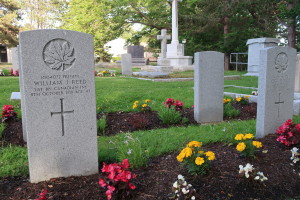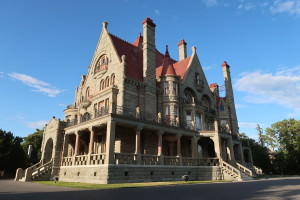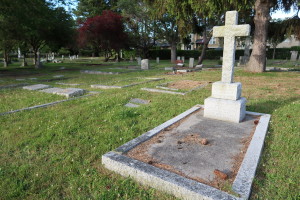Two Soldiers of Craigdarroch
Revisiting Earlier Research
This night I delve into past research to find a few words for the day. Amongst my work, from late 2014 – early 2015, I find references about two soldier graves at Ross Bay Cemetery, Victoria, B.C. As many of you are aware, I often turn to Ross Bay…its finely kept grounds well worth a wander…Within my steps I always find something new from the old…faded letters and elderly dates. Still these strings of data can offer new beginnings.
At the top of a hill in Victoria the Dunsmuir mansion known as Craigdarroch stands. This residence was once home to Joan Dunsmuir, widow of B.C. coal baron Robert Dunsmuir. The mansion, now a National Historic site, is run by the Craigdarroch Castle Historical Society. Following private ownership other uses were found for the large structure and more recently (though some time ago now) was occupied by the Victoria Academy of Music and Victoria College. Perhaps if occupants had not been found it would no longer grace its crest astride Joan Crescent. However, prior to the college and the academy and soon after the Great War an important use was found for Craigdarroch as a military convalescent hospital opened in 1919 by the Prince of Wales, Edward VIII.

Private William J. Reed, 31st Canadian Infantry Battalion. Died 8 October 1919.
(P. Ferguson image, June 2020)
Now returning to my earlier research I turn to two Great War veterans, William J. Reed and John James Kneale who both died at Craigdarroch Military Hospital. Both veterans were buried at Ross Bay Cemetery and in 2014/2015 I sought out their places of rest. Mr. Reed’s Commonwealth War Graves Commission marker was quickly found amongst two main rows of markers near to the Cross of Sacrifice. However, Mr. Kneale’s place of rest proved a challenge but, after a little more searching I discovered that Mr. Kneale was buried in a private plot. With a little more trudging I found the Kneale monument with a non-CWGC marker, not too far off from the main war graves plots and very near to the Nation family monument…an obelisk and voice that offered me the chance to stand before a memorial stained glass window in Victoria’s Christ Church Cathedral and at their son’s grave overseas.
That work, those years ago is similar, to many of my walks across the Ross Bay Cemetery. I have stood on site within the sun…and shivered within the deep cold. Sometimes in the drizzle and at times with the whirling of the wind buffeting me…I continue to search. I try not to let go, especially when I sense being close to that which I search. These visits are always rewarding…with new information and pictures in hand I return to my respite, new thoughts bounding and where I acquaint these thoughts to the keyboard, settling into the fine oversize chair wondering, tea nearby and yet with the final words wondering who I may next discover.



Comments